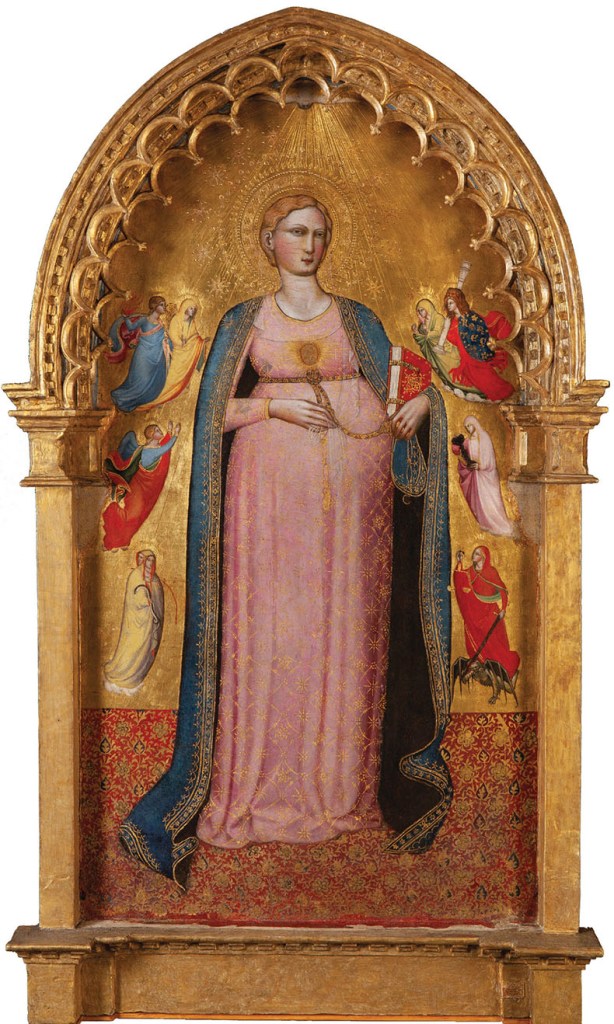From the July/August 2024 issue of Apollo. Preview and subscribe here.
In the 15th-century English mystery play The Visit to Elizabeth, there’s a scene where the pregnant Virgin Mary goes to see Elizabeth, her cousin. Elizabeth is also pregnant, grown ‘grett’ with her baby John the Baptist. In a wonderful moment of in utero gymnastics, Elizabeth describes how the ‘childe’ in her body ‘turnyd down on his knes’ before the baby in Mary’s womb. Not yet born, he recognises Jesus’s holiness; the fact that the child Mary is carrying is God himself.
I’ve always loved this vignette. It’s touchingly bizarre: a more reverent, more embodied version of the passage in the Gospel of Luke where Elizabeth describes how John ‘leaped’ in her womb when he sensed the pregnant Mary was near. It’s a moment which manages to tie Jesus’s divinity to his humanity; his fragile existence as a growing foetus.
Oddly enough, this passage came into my mind when I was visiting the Vatican a few months ago. A thousand miles away from where the play was written, and looking at a painting which predates it by a century, I caught myself remembering its curious lines. Amid the museum’s glut of religious paintings – a few hundred Madonnas, a few hundred altarpieces – I found myself in front of a work by the late 14th-century Florentine painter Cenni di Francesco di Ser Cenni. I stopped, I think, because Cenni’s Madonna is different: she has her tell-tale halo and blue cloak but her dress domes out dramatically and both of her hands brush up against her stomach. This Madonna is visibly pregnant.
Most familiar depictions of the Virgin don’t show her pregnant. She is normally nursing the Christ Child (in Italian, there is a whole genre called Madonna del Latte; ‘Madonna of the milk’), holding him, or being told of his arrival in an annunciation scene. If she is pregnant, it’s subtle – hinted at only in the context of the story of the Visitation to Elizabeth, without the artist needing to swell her figure.
Madonna del Parto (c. 1375–85), Cenni di Francesco di Ser Cenni. Vatican Museums

But when I looked further, it became clear that scenes like this – paintings of the Madonna del Parto (‘pregnant Madonna’) – were all the rage in 14th- and 15th- century Florence. Frescoes and altarpieces showed the Virgin standing alone, her hands cradling her stomach and holding a closed book – an allusion to Christ as ‘the Word’. Most versions also feature a cord around her waist: a knotted belt which legend says she later dropped to Saint Thomas at her Assumption. Cenni’s rendition is typical of the genre. His Mary is full-length and majestic as she rests the book on her bump. Surrounding her are miniature personifications of the eight Catholic virtues.
I love this depiction, the way it brings together earthy, fleshly humanity and gold-flecked divinity. Most paintings of the genre are wonderfully, frustratingly difficult for us modern viewers to parse. I’m always tempted to focus on Mary’s overwhelming frailty: how in the more famous example by Piero della Francesca (c. 1460) she looks young and exhausted, slouching forward from her hips and tugging at the seams of her maternity gown. But just as the fundamentally human nature of her pregnancy seems to be the focus, something else shifts the frame. In Cenni’s version, Mary has a gold-haloed Eucharist at her breast. While she holds a flesh-and-blood child in her stomach, she also carries his divine body in her heart. She is both pregnant mother and the tabernacle on the altar, the vessel that holds consecrated communion hosts.
There has been some debate about the purpose of these Madonna del Parto paintings and their subsequent fate at the Council of Trent (1545–63), which regularised subjects fit for religious paintings. At the Council, a decree was issued against ‘profane’ or ‘indecorous’ works and those which might encourage ‘false doctrine’. Given the Madonna del Parto paintings don’t depict a clear biblical story and instead hint at the more carnal aspects of conception and childbirth, could this have been the reason for their fall from favour? Another theory ties the works to the suppression of the Knights Templar in the 14th century, just as these paintings began to appear. According to this hypothesis, the figure of the pregnant Madonna is an allusion to a concealed truth.
But is there something far simpler at work here? In the medieval period, pregnancy was rife with difficulty. To help, a whole network of religious aid sprung up: women could make use of everything from charmed amulets to ensure conception to the intercession of saints to prevent miscarriage. Birth girdles were lent between aristocratic families to ensure safe deliveries. When I see this pregnant Madonna, it’s these anxieties which come to mind – the fears of the bodily reality of childbirth that touch even the holiest of women. Here is religious art that reaches out from its gold frame and into the congregation below.
From the July/August 2024 issue of Apollo. Preview and subscribe here.


